|
|
|
 |
 |
 |
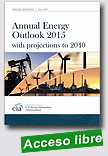 |
Annual Energy Outlook 2015
U.S. Energy Information Administration (EIA), April 2015, 154 p.
Projections in the Annual Energy Outlook 2015 (AEO2015) focus on the factors expected to shape U.S. energy markets through 2040. The projections provide a basis for examination and discussion of energy market trends and serve as a starting point for analysis of potential changes in U.S. energy policies, rules, and regulations, as well as the potential role of advanced technologies.
|
Extraído de: http://www.eia.gov/forecasts/aeo/pdf/0383(2015).pdf
|
 |
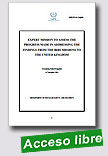 |
Expert Mission to Assess the Progress Made in Addressing the Findings from the IRRS Missions to the United Kingdom
IAEA Department of Nuclear Safety and Security, 2015, 37 p.
At the request of the Government of the United Kingdom, in 2013, an international team of senior regulatory experts conducted a third IRRS extended follow-up mission to the UK after the two earlier IRRS-missions to UK, which took place in March 2006 and February 2009. The purpose of the 2013 peer review mission was to review measures undertaken following the recommendations and suggestions of the 2006 and 2009 |
IRRS missions and to review the areas of waste management and decommissioning, occupational radiation protection and radiation sources application in order to ensure ONR had received an IRRS mission covering all ONR regulatory functions. The IAEA was also requested to review ONR’s approach to openness and transparency as well as the recently implemented ONR operating model. All except one of the suggestions from 2009 were closed and the 2013 IRRS mission resulted in 12 new suggestions and 13 new recommendations. The IRRS team at that time identified this as a ‘commendable’ result by the ONR. In June 2014, the UK Government requested the International Atomic Energy Agency to carry out a progress review mission to the UK, following on from the series of missions to the UK in 2006, 2009 and 2013. This request is the first time a member state has requested assessment against findings within a year of a peer review mission, and again the expert mission commends ONR for the support they have shown to the process, and its findings. The expert mission took place from 4 to 7 November 2014 at the ONR headquarters in Liverpool. The expert team consisted of three senior regulatory experts from three IAEA Member States and three IAEA staff members. The team carried out a review of the progress made with actions to address the findings from the previous IAEA regulatory-peer-review missions in the following areas: legislative and governmental responsibilities, responsibilities and functions of the regulatory body, management system of the regulatorybody, authorization, and the additional areas of occupational radiation protection, control of discharges, radiation source applications, waste management facilities and decommissioning.
Extraído de: http://www.onr.org.uk/documents/2015/expert-missions-report.pdf |
 |
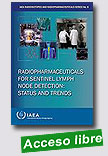 |
Radiopharmaceuticals for Sentinel Lymph Node Detection: Status and Trends
IAEA Radioisotopes and Radiopharmaceuticals Series, 2015, 162 p.
This book summarizes the current status and future trends in the development of radiopharmaceuticals for sentinel lymph node detection (SLND), an essential diagnostic tool for the effective treatment of superficial cancers such as breast tumours and melanoma. The publication covers all current aspects of this diagnostic methodology, including the |
production of nanocolloidal particles, their biological mechanism of action and relevant clinical applications. It also illustrates the recent developments in the field fuelled by the introduction of molecular imaging agents for SLND and of multimodality optical and radioactive agents. Included in the results presented in this book, are those on the novel generation of SLND radiopharmaceuticals obtained through an IAEA Coordinated Research Project.
Extraído de:
http://www-pub.iaea.org/books/IAEABooks/10713/Radiopharmaceuticals-for-Sentinel-Lymph-Node-Detection-Status-and-Trends
|
 |
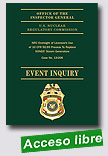 |
The Office of the Inspector General (OIG), U.S. Nuclear Regulatory Commission (NRC), initiated this event inquiry in response to concerns pertaining to NRC's oversight of replacement steam generators installed at San Onofre Nuclear Generating Station (SONGS) Units 2 and 3 in 2010
|
and 2011, respectively. Southern California Edison (SCE), the license holder for SONGS, replaced the steam generators subsequent to its application of the regulatory process described in 1 OCode of Federal Regulations (CFR) 50.59, "Changes, Tests and Experiments." 1 O CFR 50.59 establishes the conditions under which licensees may make changes to their facility or procedures and conduct tests or experiments without prior NRC approval (Le., without an amendment to their NRC license).
In January 2012, approximately 1 year after SONGS replaced its Unit 3 steam generators, control room operators identified a leak in one of Unit 3's two steam generators, and the plant was shut down in accordance with plant procedures. Initial inspection confirmed one small leak in one tube in one of the two steam generators. Continuing inspections of ali of the steam generator tubes in both Unit 3 steam generators discovered unexpected wear, including tubes rubbing against each other as well as against retainer bars. At the time the Unit 3 leak was identified, Unit 2 was shut down for a routine refueling outage. Subsequent inspections of ali Unit 2 steam generator tubes also discovered unexpected wear.
Over the next approximate year and a half, SCE pursued evaluation of Unit 3 and restart of Unit 2; however, on June 7, 2013, SCE announced its decision to permanently cease operations of SONGS Units 2 and 3. SCE's June 12, 2013, letler to NRC conveying this decision did not provide the reason for the permanent shutdown.
OIG's event inquiry examined NRC's oversight of SCE's application of the 10 CFR 50.59 process for the replacement steam generators in SONGS Units 2 and 3. OIG also sought to ascertain from NRC officials whether SONGS required a license amendment for the steam generator replacements and whether the problems at SONGS could have been identified through NRC's license amendment review process.
Extraído de: http://pbadupws.nrc.gov/docs/ml1427/ML14276A478.pdf
|
 |
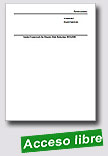 |
Sendai Framework for Disaster Risk Reduction 2015-2030
United Nations, 18 March 2015, 25 p.
The present post-2015 framework for disaster risk reduction was adopted at the Third World Conference on Disaster Risk Reduction, held from 14 to 18 March
2015 in Sendai, Miyagi, Japan, which represented a unique opportunity for countries to: (a) Adopt a concise, focused, forward-looking and action-oriented post-2015
framework for disaster risk reduction; (b) Complete the assessment and review of the implementation of the Hyogo
|
Framework for Action 2005-2015: Building Resilience of Nations and Communities to Disasters; (c) Consider the experience gained through the regional and national strategies/institutions and plans for disaster risk reduction and their recommendations, as well as relevant regional agreements under the implementation
of the Hyogo Framework for Action; (d) Identify modalities of cooperation based on commitments to implement a post-2015 framework for disaster risk reduction; (e) Determine modalities for the periodic review of the implementation of a post-2015 framework for disaster risk reduction.
During the World Conference, States also reiterated their commitment to disaster risk reduction and the building of resilience to disasters to be addressed with a renewed sense of urgency in the context of sustainable development and poverty eradication and, as appropriate, to be integrated into policies, plans, programmes, and budgets at all levels and considered within relevant frameworks.
Extraído de: http://www.wcdrr.org/uploads/Sendai_Framework_
for_Disaster_Risk_Reduction_2015-2030.pdf
|
 |
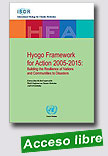
|
Hyogo Framework for Action 2005-2015: Building the Resilience of Nations and Communities to Disasters - Extract from the final report of the World Conference on Disaster Reduction
United Nations, 2007, 28 p.
The World Conference on Disaster Reduction was held from 18 to 22 January 2005 in Kobe, Hyogo, Japan, and adopted the present Framework for Action 2005-2015:
Building the Resilience of Nations and Communities to Disasters (here after referred to as the “Framework for Action”). |
The Conference provided a unique opportunity to promote a strategic and systematic approach to reducing vulnerabilities and risks to hazards. It underscored the need for, and identified ways of, building the resilience of nations and communities to disasters.
Extraído de: http://www.unisdr.org/files/1037_hyogoframeworkforactionenglish.pdf
|
 |
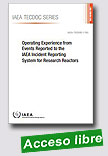 |
Operating Experience from Events Reported to the IAEA Incident Reporting System for Research Reactors
IAEA TECDOC, 2015, 64 p.
The objective of this publication is to provide the operating experience feedback from the events reported to the Incident Reporting System for Research Reactors (IRSRR) including root cause(s), lessons learned, and corrective actions taken to prevent the occurrence of similar events in other reactors.
The publication covers the analysis of the reported events to
|
the IRSRR up until September 2014 with a focus on their root causes, safety significance and lessons learned. The publication also provides the key lessons learned from the recent events in nuclear power plants that are relevant to research reactors. Reference to other publications that cover research reactor events is also included. An outline of an operating experience programme is provided, which could be useful for developing an operating experience programme in the research reactors. The publication is intended for use by research reactor operators, regulators, and designers
Extraído de: http://www-pub.iaea.org/MTCD/Publications/PDF/TE-1762_web.pdf
|
 |
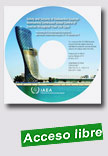 |
Proceedings of an International Conference on the Safety and Security of Radioactive Sources: Maintaining Continuous Global Control of Sources throughout their Life Cycle
IAEA Proceedings Serie, 2015, 783 p.
The IAEA works with its Member States to help them ensure the safety and security of radioactive sources. The purpose of this Conference was to review current success and challenges in ensuring the safety and security of radioactive sources and to identify means to maintain the highest level of safety and security throughout their life cycle, from manufacture to |
disposal. These Proceedings contain the opening addresses, the invited and contributed papers presented during the sessions, and summaries of the discussions. The accompanying CD-ROM contains the presentations of most of the papers presented orally, as well as the complete text of the printed volume. The CD-ROM also contains the national reports on implementation of the Code of Conduct submitted to the Conference by States, as per the formalized process established in 2006.
Extraído de:
http://www-pub.iaea.org/books/IAEABooks/10678/Proceedings-of-an-International-Conference-on-the-Safety-and-Security-of-Radioactive-Sources-Maintaining-Continuous-Global-Control-of-Sources-throughout-their-Life-Cycle
|
 |
|
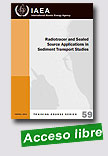
|
Radiotracer and Sealed Source Applications in Sediment Transport Studies
IAEA Training Course Series, 2015, 166 p.
The training course material on “Radiotracer and sealed source applications in sediment transport study” is not a textbook of sedimentology and even less a book exposing the theory of mechanics of fluids devoted to sediment transport in water systems. It aims primarily to describe the radioactive techniques developed and applied to study the sediment transport.
|
More than half of the world population is living on maritime shores, estuaries and on banks of the rivers, where sediment transport problems are aggravated, the mean level of the oceans has not ceased increasing (approximately 15 cm for one century), and the forecast is alarming. The direct consequence is the acceleration of littoral erosion. Related is the creation of many problems, such as maintenance of the harbor works (basins, wet docks), circulation in navigation channels, monitoring the silting process in dams (more than 36.000 in the world), etc.
The economic consequences of the uncontrolled sediment transport in the natural environment are considerable. The protection of beaches, houses, roads and dams caused by littoral erosion is very expensive. Carrying out dredging of million cubic meters of sediments to maintain navigable depths in the access channels to ports costs a lot. For example, in France it is estimated that dredging services to maintain the access of the principal ports costs each year about 100 million Euro (40 million m3).
Extraído de: http://www-pub.iaea.org/MTCD/Publications/PDF/TCS_59_web.pdf
|
 |
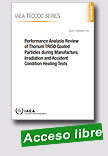 |
Performance Analysis Review of Thorium TRISO Coated Particles during Manufacture, Irradiation and Accident Condition Heating Tests
IAEA TECDOC, 2015, 86 p.
Thorium, in combination with high enriched uranium, was used in all early high temperature reactors (HTRs). Initially, the fuel was contained in a kernel of coated particles. However, particle quality was low in the 1960s and early 1970s.
Modern, high quality, tristructural isotropic (TRISO) fuel
|
particles with thorium oxide and uranium dioxide (UO2) had been manufactured since 1978 and were successfully demonstrated in irradiation and accident tests. In 1980, HTR fuels changed to low enriched uranium UO2 TRISO fuels. The wide ranging development and demonstration programme was successful, and it established a worldwide standard that is still valid today.
During the process, results of the thorium work with high quality TRISO fuel particles had not been fully evaluated or documented. This publication collects and presents the information and demonstrates the performance of thorium TRISO fuels.
Extraído de:
http://www-pub.iaea.org/books/IAEABooks/10844/Performance-
Analysis-Review-of-Thorium-TRISO-Coated-Particles-
during-Manufacture-Irradiation-and-Accident-
Condition-Heating-Tests
|
| |
| |
|
|
| |
|
|
|
| |
|
|
|
| |
|
|
|
|
|
